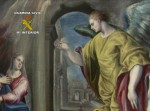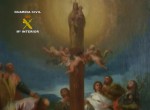 Officers with the Spanish Civil Guard have recovered two paintings, “La Anunciación” by El Greco and “La Aparición de la Virgen del Pilar” by Francisco de Goya, which were stolen 14 years ago.
Officers with the Spanish Civil Guard have recovered two paintings, “La Anunciación” by El Greco and “La Aparición de la Virgen del Pilar” by Francisco de Goya, which were stolen 14 years ago.
They were found in a villa in the Alicante region after a tip-off to police last autumn that the paintings were about to be sold. The investigation had gone cold by this point, but police were still looking and since they had alerted the Art Loss Register and Interpol when the paintings were first stolen, the thieves had found it difficult to sell such highly identifiable masterpieces. The information in the tip proved to be accurate and the police were able to track down the paintings in the private home and arrest the homeowners, who it seems were already known to the police.
Both paintings appear to be entirely undamaged, which is a relief because as counter-intuitive as it seems, oftentimes thieves have no idea how to properly care for their big score, especially when they end up having to keep the pieces for years and decades longer than they expected.
 Painted by two masters of Spanish art — although El Greco was actually from Crete, hence the name — both works are considered important parts of Spain’s cultural heritage. “The Annunciation” was painted by Doménikus Theotokópoulos, aka El Greco, in 1570 during his Venetian period (he would move to Toledo in 1577 and be welcomed as a great artist). Aragonese painter Francisco Goya created “The Apparition of the Virgin of Pilar” between 1775 and 1780. It was commissioned to decorate the altar of the church of San Pedro in Urrea de Gaén, Teruel.
Painted by two masters of Spanish art — although El Greco was actually from Crete, hence the name — both works are considered important parts of Spain’s cultural heritage. “The Annunciation” was painted by Doménikus Theotokópoulos, aka El Greco, in 1570 during his Venetian period (he would move to Toledo in 1577 and be welcomed as a great artist). Aragonese painter Francisco Goya created “The Apparition of the Virgin of Pilar” between 1775 and 1780. It was commissioned to decorate the altar of the church of San Pedro in Urrea de Gaén, Teruel.
They belonged to wealthy collector Julio Muñoz Ramonet, known to have made his fortune as a smuggler during the Franco years, who regularly lent them to museums for special exhibits. It was during an international tour that the paintings disappeared.
Ramonet died in 1991, and he left both the paintings to the city of Barcelona in his will, along with the rest of the contents of his two Barcelona mansions. The only conditions Ramonet placed on the legacy were that the city would provide for the proper preservation and maintenance of his art works and antique furniture. To ensure compliance with this condition, the city established the Julio Muñoz Ramonet foundation in 1995.
His heirs disputed the will, however, and have appealed a recent ruling in favor of the city, so right now the question of who actually owns these paintings is up in the air.
Here’s hoping that the paintings don’t get stolen away again.
Do you know how the culprits were already known to the police?
None of the articles went into specifics, so I don’t know if they were suspects in other cases or if the police had their eye on them earlier for this case.